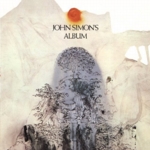|
|
 |
Dusted Reviews
Artist: John Simon Album: John Simon's Album Label: Water Review date: Aug. 1, 2005 |

|
|
|
 |
If people thought of music as a collaborative art form, similar to the movies, then John Simon might be on par with someone like legendary cinematographer and vaunted movie collaborator Haskell Wexler. As a producer for Columbia Records in the ’60s, Simon had a hand in albums by Leonard Cohen, Big Brother and the Holding Company, and perhaps most famously, produced the Band’s Music From the Big Pink and The Band. You have probably run across his work and not known it, or listened to him play on an album and not realized it. He did record three solo albums that have been released in the US: John Simon’s Album, released in 1970 and just reissued on Water Records; Journey, released in 1972, and Out on the Street from 1992. But by and large, he’s been one of those vastly influential, seldom known contributors whose work took place in the recording studio and behind the mixing board.
Water’s reissue of John Simon’s Album affords the opportunity to understand his influence directly, however. Much like the Band, Simon’s work was a stopover between psychedelia, Americana and folk. It honestly has no point of comparison these days. The arrangements can be spare, like the loping “Motorcycle Man,” harkening back to roots rock. From the sounds of things, however, Simon was never particularly concerned about whether his songs had enough twang to satisfy roots purists. There are also flourishes that are pure pop, such as the horns on “Tannenbaum” and “Davey’s on the Road Again” and Simon’s piano playing owes quite a bit to blues and jazz (unsurprising, since he also did some production work for Gil Evans). His collaborators came from all over the pop music landscape: Robbie Robertson from the Band, Carl Radle, Jim Gordon, and Bobby Whitlock from Derek and the Dominos, and folkie Cyrus Faryar.
What makes John Simon’s Album such an interesting listen is the way in which Simon folded in the talents of his various collaborators. Far from just cutting across a couple of different subgenres of rock music, he managed to fit songs into that unclassifiable space between, say, jazz, Tin Pan Alley and pop. Considering that Simon’s resume includes producing the Charles Lloyd Quartet and participating in Peter Yarrow’s examination of the late-’60s music scene You Are What You Eat, it’s a style that must have come naturally to him.
Simply put, John Simon’s Album mirrors its composer’s career. Considering the wide-ranging life Simon has led, that makes for a pretty fascinating album.
By Tom Zimpleman
|







